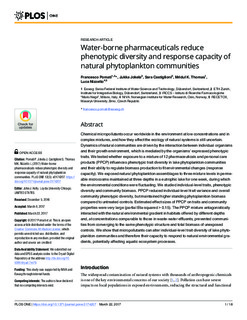| dc.contributor.author | Pomati, Francesco | |
| dc.contributor.author | Jokela, Jukka | |
| dc.contributor.author | Castiglioni, Sara | |
| dc.contributor.author | Thomas, Mridul K | |
| dc.contributor.author | Nizzetto, Luca | |
| dc.date.accessioned | 2018-08-01T11:26:49Z | |
| dc.date.available | 2018-08-01T11:26:49Z | |
| dc.date.created | 2018-01-26T10:46:55Z | |
| dc.date.issued | 2017 | |
| dc.identifier.citation | PLoS ONE. 2017, 12 (3), 18, e0174207. | nb_NO |
| dc.identifier.issn | 1932-6203 | |
| dc.identifier.uri | http://hdl.handle.net/11250/2507114 | |
| dc.description.abstract | Chemical micropollutants occur worldwide in the environment at low concentrations and in complex mixtures, and how they affect the ecology of natural systems is still uncertain. Dynamics of natural communities are driven by the interaction between individual organisms and their growth environment, which is mediated by the organisms' expressed phenotypic traits. We tested whether exposure to a mixture of 12 pharmaceuticals and personal care products (PPCP) influences phenotypic trait diversity in lake phytoplankton communities and their ability to regulate biomass production to fit environmental changes (response capacity). We exposed natural phytoplankton assemblages to three mixture levels in permeable microcosms maintained at three depths in a eutrophic lake for one week, during which the environmental conditions were fluctuating. We studied individual-level traits, phenotypic diversity and community biomass. PPCP reduced individual-level trait variance and overall community phenotypic diversity, but maintained higher standing phytoplankton biomass compared to untreated controls. Estimated effect sizes of PPCP on traits and community properties were very large (partial Eta-squared > 0.15). The PPCP mixture antagonistically interacted with the natural environmental gradient in habitats offered by different depths and, at concentrations comparable to those in waste-water effluents, prevented communities from converging to the same phenotypic structure and total biomass of unexposed controls. We show that micropollutants can alter individual-level trait diversity of lake phytoplankton communities and therefore their capacity to respond to natural environmental gradients, potentially affecting aquatic ecosystem processes. | nb_NO |
| dc.language.iso | eng | nb_NO |
| dc.publisher | Public Library of Science | nb_NO |
| dc.rights | Navngivelse 4.0 Internasjonal | * |
| dc.rights.uri | http://creativecommons.org/licenses/by/4.0/deed.no | * |
| dc.title | Water-borne pharmaceuticals reduce phenotypic diversity and response capacity of natural phytoplankton communities | nb_NO |
| dc.type | Journal article | nb_NO |
| dc.type | Peer reviewed | nb_NO |
| dc.description.version | publishedVersion | nb_NO |
| dc.rights.holder | © 2017 Pomati et al. | nb_NO |
| dc.source.pagenumber | 18 | nb_NO |
| dc.source.volume | 12 | nb_NO |
| dc.source.journal | PLoS ONE | nb_NO |
| dc.source.issue | 3 | nb_NO |
| dc.identifier.doi | 10.1371/journal.pone.0174207 | |
| dc.identifier.cristin | 1552466 | |
| cristin.unitcode | 7464,30,12,0 | |
| cristin.unitname | Akvatiske miljøgifter | |
| cristin.ispublished | true | |
| cristin.fulltext | original | |
| cristin.qualitycode | 1 | |

